The design and construction of a Student Exhibition Garden is much more than a component of our two-year Professional Horticulture Program—it’s also a practice of thoughtful expression, of boundless creativity, and of the desire to share beauty with others. This year, as part of the Professional Horticulture Program, our nine students have been asked to design, create and maintain three garden designs based on the scheme of change and adaptation. Three of the students’ concepts, conceived by Kyle Post, Allison Edmonds, and Kinga Obartuch and supported by the Professional Horticulture Program class, were selected to come to fruition—and are now fully realized and on display through September. While we shared their initial design and first steps in a previous blog post earlier this year, now’s the time to see just how these amazingly talented students brought their designs to life—and to come see their spectacular work for yourself, now proudly on view in our Gardens.
Kyle Post: The Only Way Out is Through
Getting to design and implement a Student Exhibition Garden at Longwood was a dream of mine since I first learned about the Professional Horticulture Program in 2020, when I first discovered Longwood Gardens on a road trip back from hiking in the Smoky Mountains—a day my friends I spent with our proverbial jaws on the ground, as I explored in our first blog post.
As it turns out, executing that dream was even more fulfilling, challenging, inspiring, and gratifying than I expected. Along with my incredible teammates and classmates Liz Ciskanik and Ben Helde, we created “The Only Way Out is Through”, a garden designed to see change and adaptation from two perspectives. One perspective is what we may see from the outside when others are going through change, which may look bright and full of light, beauty, and freedom. The other side is what it feels like when we are actually in the midst of change, which can feel isolating, uncomfortable and dark. While we can see those glimpses of light that are coming for us on the other side of change, we can’t yet experience them for ourselves because “the only way out is through.”
To experience those opposing viewpoints, we designed the space for guests to see bright, beautiful flowers amongst brightly painted columns, which beckon them to step inside. Once inside, those same columns serve as a way to experience the isolation and tension that inevitably come with change and adaptation, while also seeing those moments of light waiting for them.
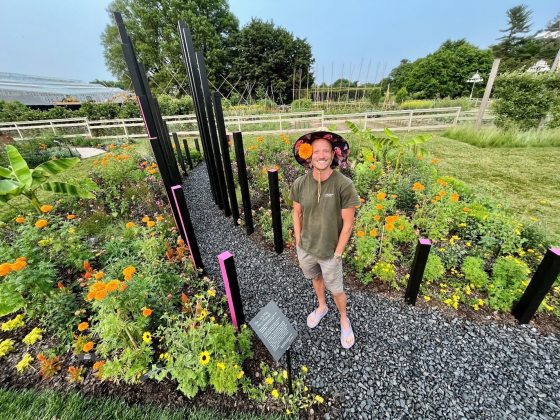
Professional Horticulture Program student Kyle Post in his The Only Way Out is Through garden space. Photo provided by Kyle Post.
From the very beginning design process to construction of the garden, to watching guests enjoy the garden today, I learned an innumerable number of things. I’d like to share just a few with you.
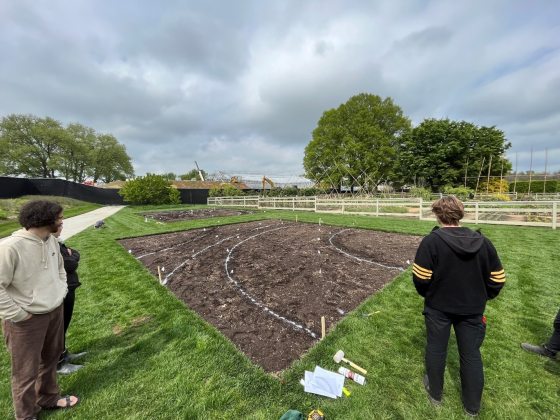
On a cloudy day in April, we started mapping out our garden space, preparing it for installation. Photo by Kyle Post.
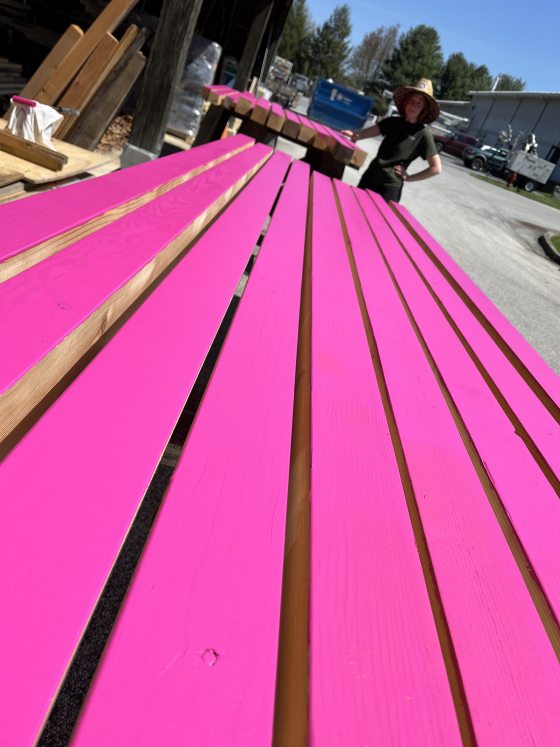
I learned that painting 31 posts up to 13 feet tall in the hot spring sun requires hard work, and the expert guidance of our incredible carpenters and paint shop. Pictured: Professional Horticulture Program student Liz Ciskanik. Photo by Kyle Post.

I learned that securing 31 posts up 10 feet tall and 2.5 feet into the earth while being spaced perfectly distanced apart, at the right height, and perfectly plumb, on a parabolic curve takes teamwork, patience, and a constant stream of fruit gummies for team morale. Pictured: Professional Horticulture Program students Liz Ciskanik and Ben Helde. Photo by Kyle Post.
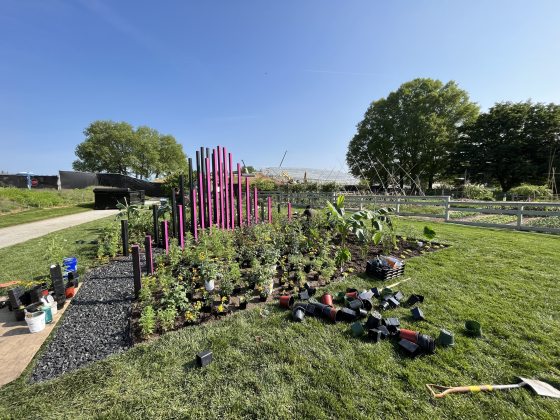
I learned that the process of ordering, reordering, tending to, placing, and planting nearly 1,000 plants takes a village and a good amount of persistence. Some favorite plants that really added the color and drama we were wanting to achieve are Dahlia ‘Zone 10’ Mystic Dreamer, Salvia ‘Amante’, and Tagetes erecta ‘Giant Orange’ Photo by Kyle Post.
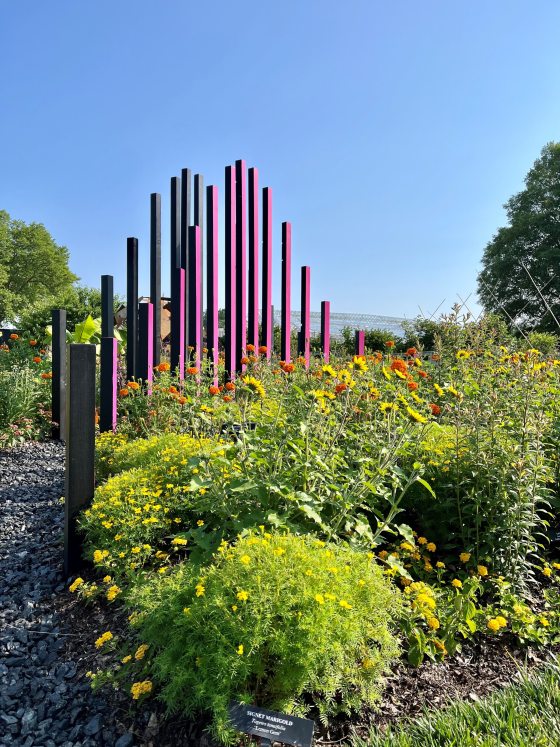
“The Only Way Out is Through”, realized. Photo by Kyle Post.
Most importantly I learned that in any creative endeavor, having an experienced mentor like our teacher Danilo Maffei is invaluable. Having a team like Liz Ciskanik and Ben Helde that has the knowledge, passion, and care to make a vision that is 100-fold better than what I could have done on my own is what dreams are made of. Having a network of professionals like those found at Longwood Gardens is what makes visions on paper come to life in reality. And getting to see guests experience living art and overhear their conversations, revelations, questions, and curiosities in all three of our Student Exhibition Garden spaces is more satisfying than anyone could ever have prepared me for when I began this dream three years ago.
Allison Edmonds: Break What Needs Fixing
For the past six to eight months, fellow Professional Horticulture Program students Faith Redcay, Rowan Nygard, and I have been working to bring our Student Exhibition Garden, titled “Break What Needs Fixing”, from concept to fruition. What a wild ride it has been! Our garden explores conformity (adaptation) and the freedom that can come from destruction (change). It is a reaction to the limiting and oppressive systems in which we live, systems that demand we change ourselves to fit within them, as through confining us to a small, stifling box. The design imagines that under this incessant pressure, we are moved to apply an equal and opposing force—to expand and burst free from the box.
A central facet of this garden’s design is its sculptural element of metal shards, which float above fissures of scorched earth as if frozen mid-explosion. From this destructive moment, rays of plants in cool blues and greens and fiery oranges and fuchsias radiate out in all directions. Guests are to experience the scene following a shockwave path, experiencing joy and curiosity and taking a moment to contemplate their inner power.
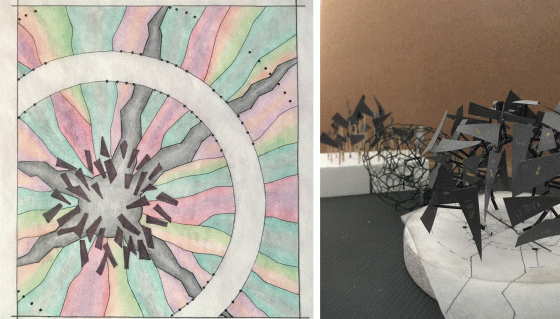
“Break What Needs Fixing” garden design sketch (left) and sculpture study models (right) by Allison Edmonds.
Prior to getting it into the ground, we spent countless hours working behind-the-scenes to build our garden’s sculptural element. This involved translating the design of a small-scale model into a life-size metal sculpture. With supervision and occasional help from Longwood’s expert metalsmith Dave Beck, we cut our steel pieces to size and methodically welded them to a steel frame to form the garden’s “explosion.”
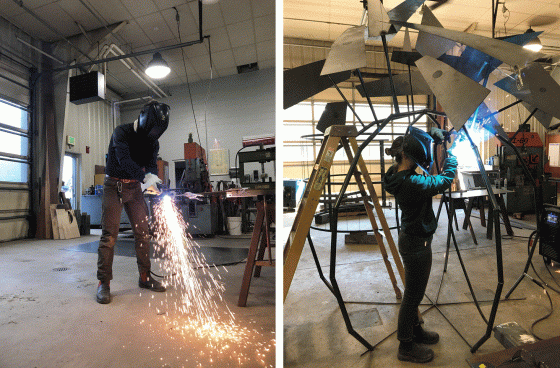
Professional Horticulture Program students Rowan Nygard (left) cuts material to size, while Faith Redcay (right) welds shards to the steel frame of our sculpture. Photos by Allison Edmonds.
During the actual garden install week, we first had to lay out our design on the bed. With measuring tape, string, stakes, and marking paint, we located crucial points for our hardscaping and the sculpture. Installing the sculpture required the help of both Longwood’s metal shop and civil division, who transported the sculpture to the site. On site, our team guided the sculpture to the correct placement in the garden.
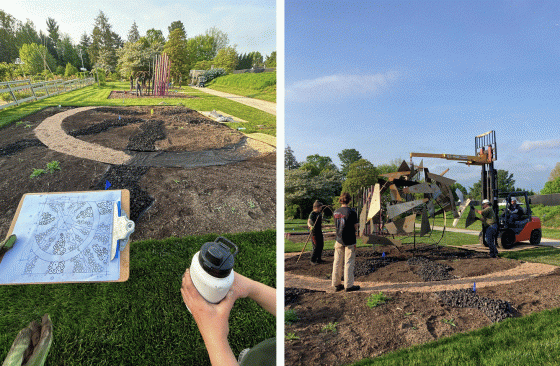
Left, the team compares their planting layout plan with hardscaping they just installed. Right, Allison Edmonds and Rowan Nygard work with Senior Mechanic and Fabricator Dave Beck and Senior Equipment Operator Brian Landis to position the metal sculpture in the garden. Photos by Rowan Nygard (left) and Faith Redcay (right).
Next, and most importantly, came the plants. For the rays radiating out from the explosion, we chose orange flowering plants such as red-hot-poker (Kniphofia ‘Backdraft’ and K. ‘Hot and Cold’), yellow cosmos (Cosmos sulphureus), and tassel-flower (Emilia sonchifolia var. javanica ‘Irish Poet’) and plants with cool hued flowers or foliage like Adam’s-needle (Yucca filamentosa ‘Excalibur’), switch grass (Panicum virgatum ‘Heavy Metal’), and culver’s-root (Veronicastrum virginicum ‘Fascination’). We had several hundred plants, sourced from local nurseries, to transport to the site, organize according to our plan, put in the ground, water in, and finesse the details. This process spanned several days. While we put much time and effort into the planning, we also had to make adjustments on the fly when quantities or quality were not what we expected and as inspiration struck throughout the process.
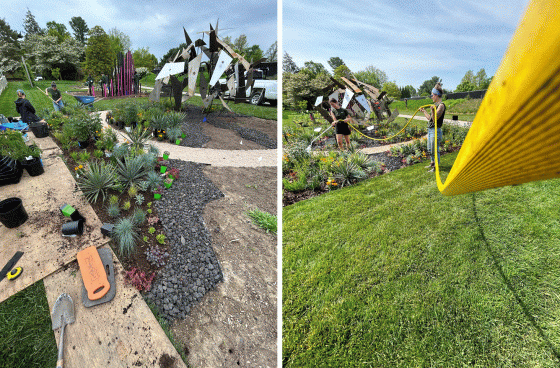
Professional Horticulture Program students Faith Redcay and Allison Edmonds get plants in the ground (left) and water them in (right) while Rowan Nygard (not pictured) documents the process. Photos by Rowan Nygard.
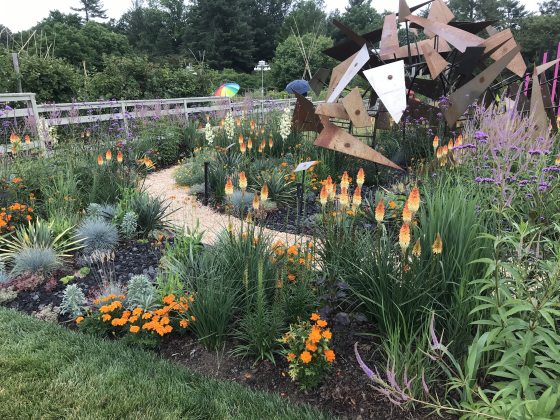
“Break What Needs Fixing”, realized. We finished installing the garden on May 12 and already it has changed quite a bit as the plants grow. Photo by Allison Edmonds.
Finally, the finished, planted result! Creating this garden and watching our classmates create theirs was an incredible experience, and we’re so proud of the results. We could not have made this happen without the unique qualities of each member of our team. We’re thankful to Longwood Gardens for giving us the opportunity to showcase our knowledge and talents and to the many expert gardeners, craftspeople, and instructors who have taught us so much along the way.
Kinga Obartuch: Loud Hands: A Stimming Garden
It is a unique opportunity to get to design, install, and care for a garden, from early sketches to a finished space open to guests, and there is no better way to wrap up our two years at Longwood’s Professional Horticulture Program. Along with my Professional Horticulture Program students and teammates Brandon Jones and Jamie Firmin, we created “Loud Hands: A Stimming Garden”.
To explain the concept of our garden, there are two words I should define: first, neurodiversity, which views certain brain-based disabilities, including autism, ADHD, and intellectual disabilities, not as disorders to be cured but as normally occurring variations in the ways human brains work, as defined by the Autistic Self-Advocacy Network, a national grassroots disability rights organization for the autistic community. Second, stimming, which refers to repetitive, sensory self-stimulating behaviors common among neurodiverse people.
Stimming can involve anything from repeating sounds (echolalia) to hand flapping or finger flicking, from touching soft textures to spinning or dancing and more. It is one of the ways that neurodiverse people like myself adapt to a world that is not built for us. We stim because it helps calm or regulate us when we are stressed or overwhelmed. But we also stim to seek joy--because we find pleasure in a particular sensation or movement or texture.
To me, this garden design is about accommodating and celebrating our differences. We created a space for other neurodiverse people to have a chance to interact with some fascinating plants, by touch, fragrance, of other interaction, and stim as loudly and excitedly as they want.
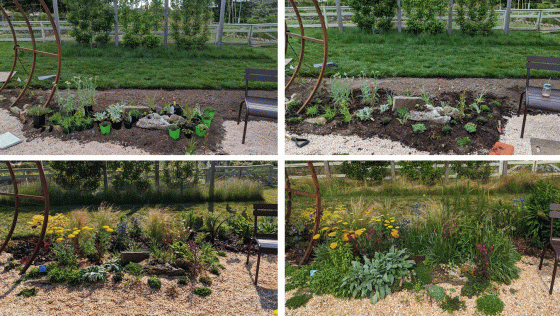
As shown in these process photos, we spent a week in May installing the gardens, transforming blank squares of soil into three unique places. Once our structures and hardscaping were installed, we turned to laying out the planting design, tweaking things until we were satisfied with the way our plants would interact with one another. Pictured: a section of our garden as we laid out plants, after planting, at the end of install, and now over a month later as everything has started to grow in. Photos by Kinga Obartuch.

My team member, Professional Horticulture Program student Brandon Jones (center), designed and took the lead on constructing our two beautiful metal arbors, with the generous help of Longwood Senior Mechanic and Fabricator Dave Beck. The vines we planted in May are beginning to clamber up the arbor, and we hope they will soon fully cover them, providing an exciting sensory experience for guests as they enter the garden. Photo by Kinga Obartuch.
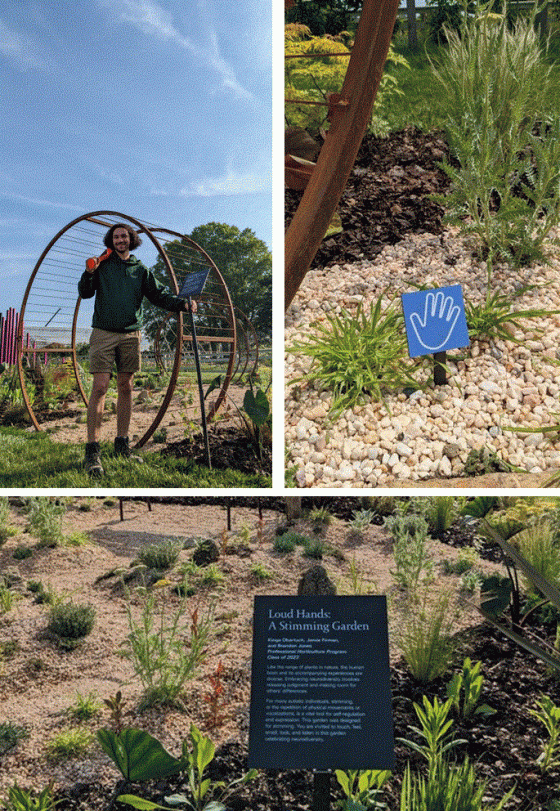
Interpretation is a major part of informing guests about the meaning of our garden. Pictured here, Professional Horticulture Program student Jamie Firman installs our interpretive sign. Jamie led the writing and development of our narrative, updating from the original paragraphs-long concept that I developed as I came up with the design, to a short and succinct couple of sentences that fits on a sign and teaches guests the significance of the garden without overloading them with information. The main sign is supplemented by several sensory icon signs, helping show guests how to interact with each plant--whether by touch, smell, sound, or vision. Photos by Kinga Obartuch.

“Loud Hands: A Stimming Garden”, realized. Photo by Kinga Obartuch.
Finally, the most gratifying part of the process so far has been guests’ response to all three of the student gardens. I have loved watching guests interact with the plants in my garden as I worked nearby, and have felt immensely proud and happy to hear feedback directly from folks--especially other autistic and neurodivergent people. From the beginning, it was vital to me that the garden teach guests about neurodiversity and be a place specifically for people to stim. I am very grateful to my teammates and everyone at Longwood that helped bring this vision to life.


